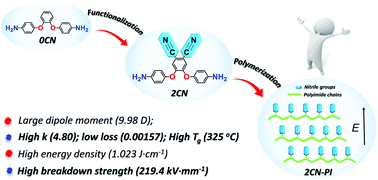Intrinsic high-k–low-loss dielectric polyimides containing ortho-position aromatic nitrile moieties: reconsideration on Clausius–Mossotti equation†
Abstract
The precision regulation of the dielectric polarization and dielectric loss of polymer materials, developing intrinsic high-performance polymers with high dielectric constant, low dielectric loss and excellent temperature resistance is very challenging. In this work, a facile molecular design strategy was developed by directly introducing two ortho-position aromatic nitrile groups into the rigid polyimide backbone. Compared with similar polyimides without nitrile groups (0CN-PIs), the polarizability and dielectric constant of the designed polyimide (2CN-PIs) can be greatly increased. Meanwhile, the polarization motions of the nitrile groups can be limited at room temperature, which is beneficial to lowering the dielectric loss. Among the designed polyimides, 2CN-BTDA shows a high k value of 4.80, low dielectric loss of 1.57 × 10−3 at 1 kHz (25 °C), and breakdown strength of 219.4 kV mm−1 with high maximum discharge energy density of 1.023 J cm−3. Moreover, its Tg value is as high as 325 °C, much higher than that of most traditional dielectric polymers. The essence of designing high-k–low-loss intrinsic polymers was revealed by reconsidering the Clausius–Mossotti equation, where the total polarizability should be maximized while the chain stacking should be as tight as possible; that is, a rigid polymer backbone, small sized polar groups (like nitrile groups), and a spatial position in favor of orientation polarization are preferred. The results are helpful to promote the research progress of dielectric polarization and of great significance to the development of high-performance high-k–low-loss dielectric materials for potential applications in modern electronic information and microelectronic industry.



 Please wait while we load your content...
Please wait while we load your content...